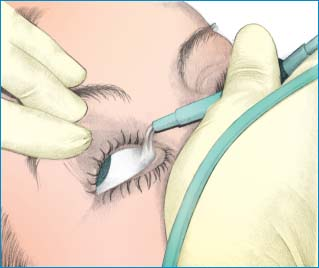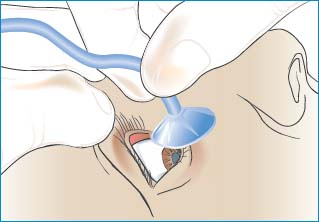Eye Irrigation
Used mainly to flush secretions, chemicals, and foreign bodies from the eye, eye irrigation also provides a way to administer medications for corneal and conjunctival disorders. In an emergency, tap water may serve as an irrigant.
The amount of solution needed to irrigate an eye depends on the contaminant. Secretions require a moderate volume; major chemical burns require a copious amount. Usually, an IV bottle or bag of normal saline solution (with IV tubing attached) supplies enough solution for continuous irrigation of a chemical burn. (See Three devices for eye irrigation.)
Equipment
Gloves ▪ goggles ▪ towels ▪ eyelid retractor ▪ sterile gauze pads ▪ 60-mL sterile syringe ▪ sterile basin ▪ emesis basin ▪ Optional: proparacaine hydrochloride topical anesthetic.
For Moderate-Volume Irrigation
Prescribed sterile ophthalmic irrigant.
For Copious Irrigation
One or more 1,000-mL bottles or bags of normal saline solution ▪ standard IV infusion set without needle ▪ IV pole.
Commercially prepared bottles of sterile ophthalmic irrigant are available. All solutions should be at body temperature: 98.6°F (37°C).
Preparation of Equipment
Read the label on the sterile ophthalmic irrigant. Double-check its sterility, strength, and expiration date.
For Moderate-Volume Irrigation
Pour the sterile irrigant into the sterile basin. Fill the syringe with 30 to 60 mL of irrigant. If you’re using a commercially prepared bottle of sterile irrigant, remove the cap from the irrigant container and place the container within easy reach. (Be sure to keep the tip of the container sterile.)
Three Devices for Eye Irrigation
Depending on the type and extent of injury, the patient’s eye may need to be irrigated using different devices.
Squeeze Bottle
For moderate-volume irrigation—to remove eye secretions, for example—apply sterile ophthalmic irrigant to the eye directly from the squeeze bottle container. Direct the stream at the inner canthus, and position the patient so the stream washes across the cornea and exits at the outer canthus.
 |
IV Tube
For copious irrigation—to treat chemical burns, for example—set up an IV bag and tubing without a needle. Use the procedure described for moderate irrigation to flush the eye for at least 15 minutes. Alkali burns may require irrigation for several hours.
 |
Morgan Lens
Connected to irrigation tubing, a Morgan lens permits continuous lavage and also delivers medication to the eye. Use an adapter to connect the lens to the IV tubing and the solution container. Begin the irrigation at the prescribed flow rate. To insert the device, ask the patient to look down as you insert the lens under the upper eyelid. Then have him look up as you retract and release the lower eyelid over the lens.
 |
For Copious Irrigation
Use aseptic technique to set up the IV tubing and the bag or bottle of normal saline solution. Hang the container on an IV pole, fill the IV tubing with the solution, and adjust the drip regulator valve to ensure an adequate but not forceful flow. Place all other equipment within easy reach.
Implementation
Verify the doctor’s order.1
Confirm the patient’s identity using at least two patient identifiers according to your facility’s policy.2
Stay updated, free articles. Join our Telegram channel

Full access? Get Clinical Tree


Get Clinical Tree app for offline access
